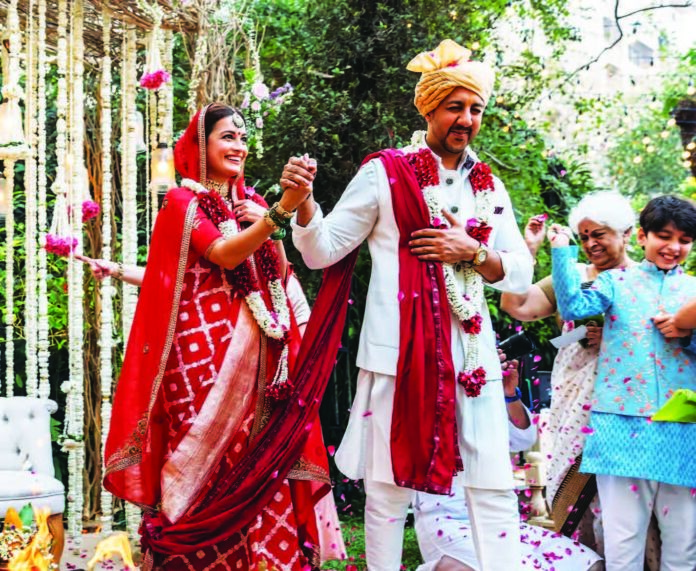India is well known for its glorious weddings – a buxom of opulent décor, glamorous outfits, and mouth-watering cuisine. What stands as a fascinating testimonial to unique Indian weddings is the history of our constitutional traditions that harmonise marriage, lives, and society.
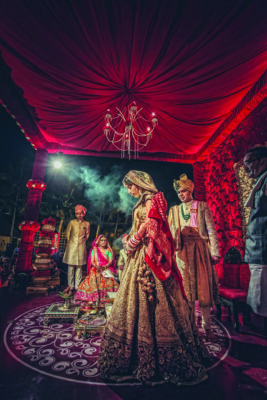
Seven Steps to Marital Bliss
Even as each ritual bears great significance, the pivot that illustrates the real essence of a Hindu marriage is the Saath Phera or Saptapadi — the seven rounds around agni, promising togetherness of a lifetime. However, the circumference of these seven circles is not confined to just the act but the words chanted as vows during these pheras. During the saath phere ritual, the bride and groom are tied in a bandhan as they take the pheras around the sacred fire believed to be the destroyer of all sins and the principal witness. The bride leads the first four rounds of the pheras as she is considered the authority to take all matters about the family and the household. The groom brings closure, with the last three rounds being the family’s protector and provider. Each of these pheras has a special significance and acts as a symbol to call out prosperity, fertility, and happiness in the couple’s union. These saath pheras change colours and meanings with India’s rich regional diversity. Regardless of their interpretation, they are paramount in concluding a wedding into a union throughout India.
The first phera prudently focuses on economic stability in a marriage. To maintain stability in their lives with dignified existence, the bride and groom vow to provide for each other and the family with nourishment, prosperity, and happiness.
The first phera prudently focuses on economic stability in a marriage. To maintain stability in their lives with dignified existence, the bride and groom vow to provide for each other and the family with nourishment, prosperity, and happiness.
The second phera symbolises persistence. The couple asks God to grant them the mental, physical, and emotional strength and endurance essential to have long and fulfilling lives.
The third phera signifies prosperity and fortune. The couple prays for a prosperously blessed married life. They promise to strive to improve both the material and spiritual aspects of life and always be devoted to each other.
The fourth phera is for love and trust. The couple promises to stand by each other in all circumstances at each happy and sad moment. Also, to continue to work harmoniously to solve every issue.
The fifth phera is for procreation. The couple prays for the well-being of all living creatures and the happiness and health of their future children.
The sixth phera denotes togetherness. The couple offers their prayers for a healthy and comfortable life. They promise to stand by one another at all costs and support one another through good and bad times.
The seventh and the final phera seals the relationship forever, where the couple makes a lifelong commitment to one another, promising their undying love, trust, and companionship and supporting each other at all costs. They seek a love-filled relationship.
The couple is pronounced husband and wife once all seven pheras have been performed. They promised to remain lifelong soul mates when they exchanged the vows of love, duty, respect, faithfulness, and a happy union.
India is a country with a rich cultural heritage. The traditions and rituals are performed in various ways, depending on the region. The purpose remains the same — the bond of promises and respect.
Saptapadi in Telugu, Malayali, Kannada and Tamil Weddings
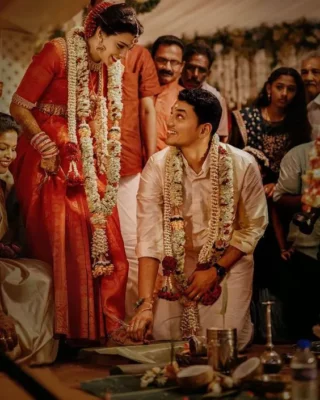
The southern peninsula of our country is rich in cultural diversity, and Saptapadi is the most significant component of a south Indian wedding. It occurs following the couple exchanging garlands at Telugu, Tamil, Malayali, and Kannada weddings. After the Saptapadi, they are showered with flowers and rice tainted with yellow. The couple takes seven rounds around the holy fire, taking vows for each step, pledging friendship and praying for plenty of food, strength, correct religious observance, happiness, and successful performance of yagnas. The bride’s feet are ornamented with silver toe rings by the groom at the end.
The Four Pheras in a Sikh Wedding
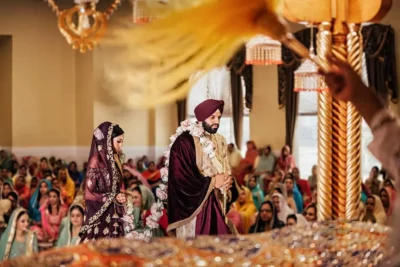
In a Sikh wedding, once the morning hymns are over, the bride and the groom take four pheras around the holy Granth Sahib. The four laavan (rounds) are performed in a clockwise direction, which is the most eccentric aspect of the wedding. The couple bows to pray after one laavan is completed and waits for the second to start. They are pronounced man and wife after the fourth and final laavan.
Saptapadi of an Odiya Wedding
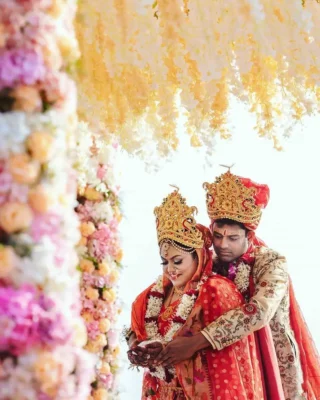
For an Odiya wedding, seven small rice mounds that have been blessed by the priest are placed on the ground. These seven mounds of rice represent the seven hills, or Saptakil Parwatas, symbolising the hardships they may face during their marriage. The bride breaks these piles of rice with her right foot, marking the seven-stage path to happily ever after. The bride’s brother completes the Saptapadi rite by placing puffed rice on the bride’s palm (then placed on the groom’s palm) to symbolise wealth.
Unique Bengali wedding Saptapadi
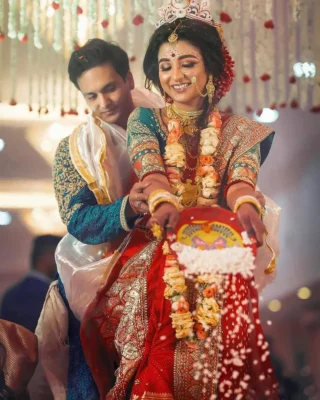
In West Bengal, the bride leads the final three pheras while the husband leads the first four. However, the Bengali Saptapadi is unique from the conventional Saath Pheres. Seven betel leaves are arranged in a straight line on the floor of the mandap as part of the Bengali Saptapadi ritual. The bride treads on the betel leaf one by one once after each phera is completed. Turmeric and vermillion, often known as ‘haldi and kumkum’, are applied to the leaves to ensure purity. On the other side, the groom rolls a grinding stone known as a nora with his toe during the pheras.
Unusual Pheras of a Coorgi Wedding
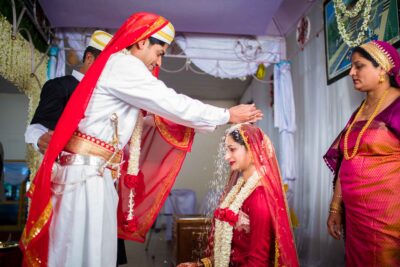
In a coorgi wedding, fire does not play any role. A mat facing north-south is spread, and a sacred lamp is lit at the muhurta location. A low stool called a mukkali is positioned in the middle and covered with a red fabric. On either side are two more stools that are topped with a silver plate that contains a heap of rice. One of the rice heaps is topped with a kindi (a small metal pot with a spout). The bride or groom takes three rounds around the main mukkali with their best man or best lady. They stand in front of the mukkali, sprinkle rice on it three times, and then pray by touching it with both hands.





